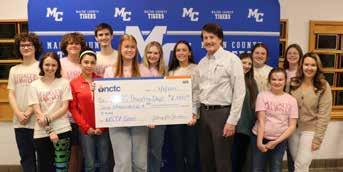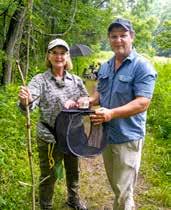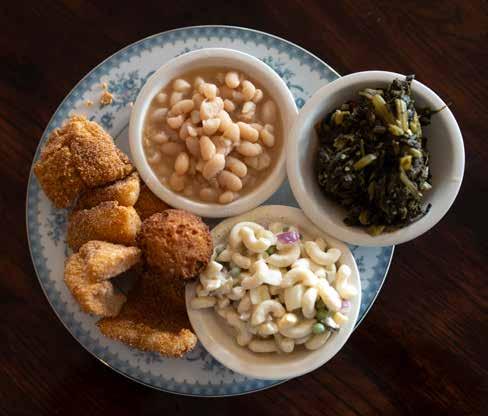




By Shirley Bloomfield, CEO NTCA–The Rural Broadband Association
NTCA members create broadband networks so fast and reliable that it’s easy to take for granted the effort and expertise needed to bring these services to homes and businesses. These professionals do amazing work, particularly when considering the intricate, multistep journey to build, expand and maintain a network.
It begins with detailed research and careful planning. The broadband provider must learn exactly how many homes and businesses might want service, as well as the challenges posed by the landscape. Then, a thorough review of the numbers determines if the project makes financial sense. It’s a puzzle where the pieces are population density, infrastructure costs and potential demand for the service.
Then there’s the engineering—design, build and inspect. Detailed maps identify routes for cables, permitting, environmental regulations and access to land. Some of these projects can take two to four years from the first engineering drawing to the first connection.
The work doesn’t stop when the network goes live. These networks require maintenance, technology upgrades and customer support.
These networks are lifelines connecting rural communities to telehealth, education, remote work and cutting-edge technologies. With the help of service providers like yours, we’re building broadband to last and ensuring no community gets left behind in our increasingly digital world.
To learn more, check out the Foundation for Rural Service and JSI’s latest report, “Delivering Broadband From Beginning to ‘End,’” at frs.org/deliveringbroadband-beginning-end.

When you need information fast, a quick check of Google is often the first stop. In fact, some people find it easier to search online for everything, including the addresses for a specific website like a bank, trusted repair service or health care provider.
Unfortunately, scammers know this, too, so they sometimes create bogus sites with addresses confusingly close to the real thing.
Google is aware of this trend, and it touts advanced systems that keep users’ search results 99% spam-free. The company also offers a few tips for closing the final security weaknesses.
• Pay close attention to the URL—the specific web address—before clicking any unfamiliar link. Typically, in an email, hovering the cursor over the address will show the complete link. Don’t click the link if it looks suspicious.
• The three dots next to the search results in Google can be used to find more details about the webpage, store or business you’re considering. You can find clues indicating if the site is legitimate before clicking the link.
• When you’re looking for official resources, watch out for unusual address formatting. For example, there’s typically only one correct customer service number for a larger company. But not all businesses have customer service numbers, and searching for them requires you to be mindful. Watch for strange formatting in the website address, including unexpected symbols or emojis.

Story by BRANDI DIXON
Hannah Dasher is a blast of classic country and rock ’n’ roll paired with social media influencer. Stepping into the home she calls “Honky-Tonk Graceland” and features on her social media is, as Hannah says, like going back in time to “your meemaw’s house.”
“Avocado green canisters, gold salt and pepper shakers, brass pots. I love my retro kitchen, and I love that the fans feel right at home,” she says, adding that she enjoys entertaining.
Music and songwriting are Hannah’s first loves. “I was rehearsing my acceptance speech for best new female vocalist of the year in my mirror at age 10,” she says. “I grew up listening to ’90s country radio, and knew I wanted to be an entertainer.”
Hannah pursued music professionally, taking her big hair and a heaping helping of Southern charm to Nashville, Tennessee. She started out writing songs for other artists, getting some big accolades thanks to collaborations with Brad
Paisley, Lainey Wilson and Ian Munsick, to name a few. She continued performing whenever she had the chance.
In 2020 during the pandemic, Hannah found herself stuck. “All the stages shut down, and I needed a stage,” she says. “Talking with some friends I learned a lot of girls my age couldn’t cook, so I stumbled into the world of social media, and it was the perfect storm.”
Hannah took to TikTok to share her
family’s beloved recipes and a few of her own, all while sprinkling in a bit of her signature rockin’ country flavor. The recipe produced the now-viral Stand By Your Pan social media accounts. More than 1.5 million followers join Hannah daily in her retro kitchen.
“I love that this brought country and noncountry music fans together,” she says. “It’s hard to pigeonhole into just one world, and I’m glad that I can be this representative of the past and the future via a semicelebrity chef.”
When Hannah Dasher isn’t cranking out content, she’s picking up a guitar and writing music.
“God always sends it from the left side of the sky and out of my mouth,” she says of her process. “Sometimes it’s melody and lyrics simultaneously, but you just never know, and you always have to be looking for it.”
Hannah is on the road this year with her band on The Wanted Tour, featuring stops across the United States, the United Kingdom and Sweden. She encourages fans to spread the word and come see her and her “boys.”
There’s something magical when technology becomes so advanced that it simply works, without muss, fuss or the need for advanced skills. Your smartphone is a great example, particularly whatever app you prefer for photos. Looking for an image of your cat or dog, a mountain or a beach? Just ask and the search will likely provide shockingly good results.

MCCLANAHAN President/CEO
That app simply does the job, and our internet service is much the same—it simply works. It’s fast, reliable and resilient. Thanks to the long-term investments to create a fiber optic network supported by a team of local professionals, we can provide services that unlock the online world. If you consider internet access essential, there’s no better option.
Whether you’re working from home, attending virtual classes or binge-watching your favorite shows, fiber makes sure everything runs smoothly. Do you have multiple devices online at once, rely on video calls or enjoy challenging online games? No problem. The performance is there whenever you need it.
It’s important to remember, not all technologies have the same benefit. They may work, but not as well as fiber. With those other systems, storms might block signals or otherwise create interruptions. However, compared with other technologies, our fiber network is designed to not only stay online more reliably but also bounce back more quickly if there is an outage.
Not every community gets to enjoy this type of internet service. We designed our fiber network for today with features capable of handling future online tools and resources. Considering how quickly technology is advancing, an adaptable network is vital for our community to stay competitive in an increasingly online world.
After all, high-speed internet is more than a nice-to-have luxury. From telehealth services to online education, fiber optic networks give us access to essential resources that fundamentally improve our quality of life. Similarly, reliable, fast internet energizes our economy. From established area businesses to new entrepreneurs, the internet provides the tools needed to compete.
We’re committed to bringing these benefits to every corner of our community. And please remember, NCTC is about more than the physical network. The dedicated professionals making up our team live here, believe in our area’s future and are committed to providing unparalleled support.
So, this year let’s celebrate the progress we’ve made and look forward to a future where everyone can enjoy the advantages of cutting-edge technology. Our goal is to ensure no one is left behind and that everyone has access to the opportunities high-speed internet provides. Thank you for your continued support and trust. Together, we’re building a brighter, more connected future.
The North Central Connection is a bimonthly newsletter published by NCTC, © 2025. It is distributed without charge to all member/ owners of the cooperative.


North Central is a member-owned corporation dedicated to delivering advanced telecommunications technology to the people of Northern Middle Tennessee and Southern Kentucky, including Macon County, Tennessee, Allen County and Warren County, Kentucky. NCTC also serves portions of Sumner, Trousdale, Smith and Clay counties in Tennessee.
North Central
872 Highway 52 Bypass E. P.O. Box 70 Lafayette, TN 37083 Telephone: 615-666-2151 www.nctc.com
Glen Hardcastle
Chairman of the Board
Scottsville Exchange West
Randy Harston
Vice Chairman of the Board
Scottsville Exchange East
Calvin Graves
Secretary of the Board
Bethpage/Oak Grove Exchanges
Martha Bowser
Westmoreland Exchange
Kevin Dickerson
Defeated/Pleasant Shade Exchanges
Donnie Steen
Lafayette Exchange East
Jeff Flippin
Lafayette Exchange West
Chad Evitts
Hillsdale/Green Grove Exchanges
Chad Owens
Red Boiling Springs Exchange
Johnny McClanahan
President/CEO
Guy Holliman
General Counsel
Produced for North Central by:

the
Store in Bethpage as a way to bring the community together. See story Page 12.























NCTC is grateful for the service and sacrifices of those who gave all. Please join us in recognizing our fallen military heroes on Memorial Day. In observance of the holiday, our offices will be closed on Monday, May 26.
If you receive your home phone service through our state-of-the-art fiber optic network, it requires electric power to operate. To avoid a disruption of home voice service during a power outage—and to maintain the ability to connect to 911 emergency services a standard corded phone is required. Our battery backups are expected to last eight hours on standby power. That means the backup battery should give you about six hours of talk time. If you feel this is not enough time, you may extend your standby power by purchasing a 24-hour battery or additional eight-hour batteries. Our battery backup does not provide power to any services other than voice. Home security systems, medical monitoring devices, routers and other equipment will not run on a phone backup battery. Unless you are otherwise notified in advance or in cases of abuse to our equipment, NCTC will maintain the power unit for three years from the date of installation.

NCTC recently granted $2,000 to Macon County High School’s theater department as part of an initiative to support music education programs. Presented by NCTC President and CEO Johnny McClanahan, the award was used to help offset the cost of the performance license for “Legally Blonde: The Musical.”
NCTC offered the grant through its partnership with AXS TV’s Band Together for Music Education program, which connects local affiliates with school music education programs across the country. The initiative was created to help local arts programs during a time of slashed budgets and a severe lack of funding for arts and music programs in public schools. It’s one of the few programs in the county that includes K-12 students across the district, as well as homeschool students.
Grant winners are chosen based on merit and need. “These recipients are established programs that exemplify top leadership, instruction and participation, yet also demonstrate a strong need for further funding and support,” a Band Together new release reads.
“This is one more way we like to look out for our communities,” McClanahan says. “NCTC is locally owned and operated, and we want to make sure we support the people in our service territory.”
NCTC President and CEO Johnny McClanahan, right, presents a check for $2,000 to Kelly Blackwood, adviser for Macon County High School’s theater department. They are surrounded by several cast members from the department’s recent show “Legally Blonde: The Musical.”



Story by JOHN CLAYTON
Ric Sisler admits he misses the annual spring-to-fall marathon of a baseball season. “When it’s in your blood, it doesn’t matter what you’re doing. You’re always going to be pulled toward that industry, and I’m
WHAT’S IN A NAME?
certainly no exception,” he says. “Going to the ballpark, the camaraderie and being around the yard was just a thrill for me.
“I certainly don’t miss tarp pulls and some of those types of things,”
Marketers and merchandisers will say quite a lot. Creative—some may say outlandish—nicknames, mascots and logos are part of the landscape of minor league baseball. Here are a few of our favorites:
Florida: The Fort Myers Mighty Mussels—The nickname is more about seafood than sinew.
Alabama: Rocket City Trash Pandas—It pairs Huntsville’s role in the space industry with a cute raccoon reference.
Georgia: Augusta GreenJackets—The GreenJackets mascot is
Road trip to baseball’s most entertaining destinations
he says with a laugh, referring to the back-breaking work of getting protective tarps on and off the diamond during rainy weather.
The national pastime is most certainly in Ric’s blood. He played for three
akin to a yellow jacket, but the reference is to Augusta’s long history with The Masters golf tournament, which awards the winner a green jacket.
North Carolina: Kannapolis Cannon Ballers—The alliteration is nice for the team once known as the Intimidators after the late NASCAR star and Kannapolis native Dale Earnhardt Sr., who was then part-owner of the team. The Cannon Ballers mascot, Boomer, has an uncanny resemblance to Earnhardt.
Kentucky: Bowling Green Hot Rods—The nickname gives the team a link to the nearby National Corvette Museum.

seasons in the New York Yankees minor league system before running several minor league organizations as a front office executive and as vice president/ general manager of the independent South Coast League based in Georgia. His father, Dick Sisler, was a Major League Baseball manager and All-Star player, and his grandfather, George Sisler, is enshrined in the National Baseball Hall of Fame.
Ric, who is still involved in athletics as director of corporate sponsorships at Western Carolina University, says many fans of the game come back season after season.
“Minor league baseball has been part of the fabric of our society in a lot of smaller towns,” he says. “It was kind of a binding agent for folks to come watch baseball with their friends and neighbors and just have a wholesome time.”
While the minor leagues are about family fun and community pride to many fans, the game is a balance of business and player development for the teams and their MLB affiliates. The minors have long relied on fan-friendly, creative promotions and player interactions to sell tickets, and all of that comes with an affordable price tag.
“I think people have always gone to minor league games because it’s
affordable,” Ric says. “You had great entertainment and could see some potential big-league players there at

an affordable price. You’re very close to the field and close to the players. It was a different setting from the Major League parks. I don’t want to see that change.”
Planning a trip this summer––or maybe even a baseball pilgrimage? There’s a game, sports history and tradition, as well as a bunch of fun waiting for you.
Some of the oldest ballparks in the country are in the Southeast, and three of them are on the National Register of Historic Places.
That list includes Birmingham, Alabama’s Rickwood Field, which is the nation’s oldest professional baseball park still with its original structure. Opened in 1910, two years before Boston’s Fenway Park, Rickwood was home to the Negro Leagues’ Birmingham Black Barons.
The double-A Birmingham Barons play an annual ceremonial game at Rickwood, and Major League Baseball hosted a game between the St. Louis Cardinals and San Francisco Giants at the venerable ballpark last season, a 6-5 Cardinals victory.
Jackie Robinson Ballpark in Daytona Beach, Florida, was the first ballpark to allow the Brooklyn Dodgers’ African American prospect whose name now graces the stadium to play with white players in the segregated South in 1946. The park dates to 1914 and was originally named Daytona City Island Ballpark.
Spartanburg, South Carolina’s Duncan Park was constructed in 1926 and was home to minor league baseball almost continually until 1994. It was also home to the Spartanburg Sluggers, a Negro League minors team from 1928-52. An estimated 21,000 spectators reportedly crowded in and around the ballpark to attend Game 5 of the 1938 American Legion World Series between Spartanburg and Los Angeles.
The 3,000-seat stadium is currently Spartanburg High School’s home field. The city of Spartanburg is building a new stadium for the Hub City Spartanburgers of the South Atlantic League. The city is the new home of the former Down East Wood Ducks of Kinston, North Carolina.

Story by JEN CALHOUN
Nearly every time Joe Aiken walks into the grocery store wearing his company’s brand logo he gets stopped.
“I’ll hear something like, ‘Hey, my uncle works there,’ or ‘My mom used to work there,’” says Aiken, plant manager of The J.M. Smucker Company’s Scottsville location. “There’s a couple of generations of families that work here or have worked here, so it’s interesting to see how much influence there is in the community.”
The 180,000-square-foot manufacturing facility opened in 2004 with an initial workforce of about 225 employees. It became the first Smucker plant dedicated to the Uncrustables brand— prepackaged, frozen, crust-free sandwiches filled with peanut butter and jelly and other popular spreads.
Since opening, the facility has expanded by at least 80,000 square feet, and it now employs more than 500 people. In addition, Smucker added two more plants

dedicated to making Uncrustables––one in Longmont, Colorado, and another in McCalla, Alabama.
A primary reason for the sandwiches’ widespread appeal is the Scottsville plant and its employees. “Really, the genesis of the popularity of Uncrustables and the initial push is because of the Scottsville employees and everything they’ve done,” Aiken says. “For years, we couldn’t meet the demand for the product because it was so popular. Our ability to get it into
households and establish the brand is because of the Scottsville team and their hard work.”
The relationship between the company and the community is mutually beneficial, says Scottsville Mayor David Burch. “Their reliable employment record creates a reassuring sense of economic stability in our community,” he says.
The J.M. Smucker Company got its start in 1897 in Orrville, Ohio, when Jerome Monroe Smucker started selling apple butter out of a horse-drawn wagon.
The Smucker company continued to grow and expand over the 20th century by shipping its products across the country and building new facilities. It went public in the late 1950s, but it’s still family-run. It’s currently in its fifth generation of family leadership, Aiken says. Today, Smucker still makes and sells apple butter along with many other products, including Smucker’s fruit spreads, Jif peanut butter, Folgers and Dunkin’ coffees, Hostess baked goods and pet food products like Milk-Bone and Meow Mix, to name a few.
When the Scottsville plant was initially built, fiber-powered broadband networks weren’t available throughout the country the way they are now. Today, they’re an important part of the nation’s infrastructure.

To find out more about working at The J.M. Smucker Company and apply for an open position, visit jmsmucker.com/careers.The webpage offers more information on the company, the interview process and a link to lists of open positions. The positions can be sorted by plant location, job category or type, full-time or parttime positions, hybrid and remote considerations and more.
Thanks to NCTC, the people and businesses of Scottsville were able to access ultrahigh-speed fiber broadband service before their counterparts in much larger cities. That access helped companies like Smucker stay connected.
“We certainly rely on communication with our employees, and we use the internet to communicate externally, as well,” Aiken says.
Burch says the quality of the internet service in Scottsville is the top question asked by businesses and people interested in moving to the city. “Our high-speed internet is the envy of other communities,” the mayor says.
Because of NCTC, 98% of Allen County residents have access to broadband, making it one of the top-ranked counties in the state, says Burch, quoting the statistic from a study by Barren River Area Development District. BRADD is an organization working to preserve and enhance the lives of people in the region through planning, economic development and other measures.
“Broadband provides opportunities for
companies that require high-speed and reliable internet,” he says. “We all experienced the importance of NCTC’s fiber broadband during the COVID pandemic. Its reliability and speed are even more appreciated and necessary as we move forward.”
Since the Scottsville plant opened, it’s become part of the town’s identity. From the beginning, Burch says, Smucker “has been a consistent and dependable partner in multiple community endeavors.”
Aiken says he’s proud of the connections the company makes in the community. “I think about the different roles that we play here,” he says. “Smucker gets involved with community activities. We help with the First Fridays on the Square, and we donate so much to the community.”
Things like that are important, because many people in town have family members who work at the plant. They’re proud of the brand they’ve helped Smucker build.
“They know it all started here,” Aiken says.


Story by SARA DIAMOND PATTERSON
Catching lightning bugs in a Mason jar with holes punched in the lid is a summer ritual for kids across the country. Watching their light show together is often a time for families to slow down, which is what Lynn Frierson Faust’s family began doing in the Great Smoky Mountains during the 1960s.
They marveled for years at the unique light display, as the flying beetles blinked on and off at the same time for several hours after dark. When Lynn heard the August 1991 edition of Science News magazine featured an article on fireflies that blink in unison, she figured she would finally find out why and how they made their magic.
“I remember thinking, ‘Oh cool, a lightning bug feature. It’ll talk about our light show.’ Only it didn’t mention one thing,” she says. In fact,
the authors said the Western Hemisphere had no species of fireflies that blinked synchronously.
Lynn let them know they were mistaken and invited them to come to the Smokies to see the show for themselves. The scientists did and agreed Lynn was right, lighting the way for her life’s work.
‘JUST SO DARN FUN’
As “The Lightning Bug Lady,” Lynn is internationally known for her research on the ecology and habits of the more than 125 species of U.S. fireflies, helping
HOW: Fireflies produce their magical flashes through bioluminescence, a chemical reaction.
WHY: Each of the more than 125 species of fireflies in the United States—2,000 worldwide—has a unique signature flash pattern the males use to attract females of their specific type.
WHERE: Everywhere. Many Western species do not flash or fly, but they’re out there.
WHEN: Warm summer nights.

Pesticides and habitat reduction have taken a toll on firefly populations. Maintaining a “wild” area of your yard with a little water, native vegetation and undisturbed soil will make your home more firefly friendly. But the easiest way to help is simply by turning out the lights during their active period. Visit xerces.org or firefly.org for more tips.


A BBC crew takes a break from filming in 2019. Naturalist Lynn Frierson Faust examines equipment she and Mark Zloba, ecological manager at the Edge of Appalachia, use to gather fireflies at the preserve outside of Cincinnati.
to raise awareness of their unique life cycles and importance within ecosystems.
She scrambles to 14 states each year to catch them emerging during their eight-week active season, usually early June to late July. For 18 years, she has been the worldwide go-to on the subject, serving as on-site scientific consultant for BBC Earth, Discovery, National Geographic and other international film crews. Lynn’s 2017 book, “Fireflies, Glow-worms, and Lightning Bugs,” was the first-ever comprehensive firefly field guide and shared the results of her nearly three decades of research on behalf of museums, universities, state and national parks and nature centers.
“I’m not a scientist per se, but I’ve done the research, a whole lot of research,” she says. “I’m just a regular person obsessed with these and fortunate to have the time and a little knowledge to build on.”
Throughout history, fireflies have symbolized hope and mystery, serving as transient reminders that life is fleeting. In some cultures, people see them as their lost ancestors, a sacred connection between the earthly and spiritual worlds.
When she began, Lynn didn’t have much research to start with. “There were just a bunch of dusty old scientific papers, but that’s about it,” she says. “There’s just not been that much research done on them since they aren’t harmful or helpful to people or crops.”
They are, however, a great indicator species for the health of ecosystems. “When they disappear, we have to know why and where to look.” And
No matter where you are, you don’t have to go far to find the magic. You can look for lightning bugs anywhere from your backyard to wildlife management areas or wooded parks, avoiding light pollution and areas that spray for mosquitos.
The Southeast offers the most variety of firefly species. “Generally speaking—and this holds true for almost all living things—as you go south closer toward the equator, you get a greater diversity of species but maybe fewer numbers,” firefly expert Lynn Frierson Faust says. “Whereas when you go north in latitude, you get greater numbers but fewer species.”
The Photinus carolinus species in the Great Smoky Mountains National Park of Tennessee and North Carolina are known for their synchronous flashes. You can see them put on a similar show at South Carolina’s Congaree National Park. Thousands of these fireflies emit between five to eight flashes of light all at once followed by eight to 10 seconds of darkness.
Their light shows have become so popular, each year more than 20,000 people enter a lottery drawing at each park for viewing spots during the two-week active period, usually in early June depending on temperatures and soil moisture.
Lynn says they will always serve as a nostalgic reminder of days gone by.
“Lightning bugs are fantastic ambassadors leading people back into nature and to a better understanding of the connectedness of it all,” she says. “Plus, they’re just so darn fun.”
Officially known as Lampyridae, worldwide fireflies are called blinkies, glowflies, moon bugs, peeneywallies, blinkin’ bees, hoturu, fire beetles and candle flies. Here at home, “lightning bug” is more common in the South and Midwest, while “firefly” is typically heard in the West and large cities in the East. Some researchers attribute the differences to weather. While lightning is most active in the South and Midwest, the West sees the most wildfires.
Story by JEN CALHOUN
Three years ago, Tara and Tony Milliken bought a 10,000-square-foot building not far from their farm in Bethpage. But they weren’t quite sure what to do with it.
“Then we were like, ‘Why not make it into an oldfashioned general store?’” says Tara, who now owns and operates The Ole Milliken Store, a new general store with a 1920s country feel.
“We wanted a place where people could come to shop, eat and hang out,” she says. “Mostly, we wanted a space for the community. We wanted to go back in time to when times were slower and people could sit and talk to their neighbors.”
After renovations, which included adding old wooden floors and tin ceilings, The Ole Milliken Store opened in January 2023.
Like the country stores from way back when, the shop sells everything from seed packets to animal feed, homemade candles and vintage glass-bottle sodas. Gift items sit alongside seasonal decor and furniture. And if that’s not enough, an ice cream bar in the back whips up milkshakes and floats.
The Ole Milliken Store was named one of the 10 most charming country stores in the South by the readers of Southern Living magazine. Southern Living says of the Bethpage mom-and-pop shop: “Its schedule of weekly and monthly events like a farmers market, trade day, cruise-in for car enthusiasts and networking meet-up prove that The Ole Milliken is much more than the contents of its shelves.”
The restaurant side of the shop serves lunch platters of country cooking made from scratch. Typical choices for the meatand-three plates might include fried catfish and hush puppies, fried pork chops or hamburgers with sides of fries, onion rings, squash casserole, mashed potatoes, green beans, white beans or turnip greens.
“When I say made from scratch, I mean it,” Tara says. “We don’t do things from a box. It’s all fresh ingredients.”
The Ole Milliken Store is the family’s first time opening a general store/restaurant, but they’ve been running businesses for a while now. The store is under the umbrella of the Milliken Corp., whose brands include Milliken Builders, Milliken Rentals and Tennessee Tuff Trucks, a reseller for vintage Ford trucks. The corporation also operates a nonprofit foundation that raises awareness about the benefits of working in the trades.
The company uses NCTC’s fiber broadband connection to keep its operations running smoothly, whether it’s through internal and external communications or websites and social media accounts. The general store maintains active Facebook, Instagram and TikTok accounts, and it offers an email newsletter for anyone who visits the store and signs up for it.
Their latest venture has been a labor of love, says Tara, who always liked the idea of stores that give rural people a place to buy some sugar, a bag of feed or some candy. General stores like those served a greater purpose in rural life, because they sold a bit of everything people might need.

“My mom always said, ‘Tara, you were born in the wrong era,’” Tara says. “My heart and Tony’s heart are more in the old style of living where you’re sitting with your neighbor or baking a pie for a friend. I think we just lost sight of that. We’ve just lost sight of that slow living, that slower way of life. As we forget those things, I feel like we forget ourselves a little bit.”
Feeding people is a big part of bringing back those forgotten community connections. It’s another way to offer love and care. “We have six children,” she says. “Four of them are boys. And while most of them are out of the house now, it wasn’t unusual for me to have at least 20 kids in the house on a given weekend. And that’s something that’s a passion of mine––to cook and to cook well.”
Currently, the restaurant portion of the store is open for lunch Wednesday through Saturday and for breakfast on Saturday. But Tara believes they could expand into Sundays, and they may start offering dinners. Eventually, they hope to sell honey, meats, eggs and produce from their farm.
There’s also more space in the building that could be developed. Ideas floating around include a game room or arcade. But none of that has been decided yet.
In the meantime, Tara says it’s important to help where they can. They offer a blessing box out front filled with food items
The Ole Milliken Store is at 1196 Harve Brown Road in Bethpage. Check out the latest information and events by visiting The Ole Milliken Store Facebook, Instagram and TikTok sites. The website is theolemillikenstore.com.



ABOVE: Milliken’s serves made-from-scratch lunches Wednesday through Saturday, as well as a Saturday-morning breakfast.
TOP LEFT: Tara Milliken says The Ole Milliken Store is a return to a time when things were slower paced.
TOP RIGHT: The store opened in January 2023.
for people in need, and they support local sports teams and other projects. “That’s been the big thing for us,” Tara says.
“Love on your community. That’s our goal.”

Many say munching on piping-hot, crispy fried chicken is a joy like no other. Whether it’s juicy white meat from the breast or the wings or the deep, engaging flavors of the dark meat found in thighs and legs, when it comes to fried chicken, most everyone has a preference. But there are a few things that good pieces of fried chicken have in common—the skin must stay on, and it must be crispy.
That’s not too much to ask, but it’s something that many cooks cannot achieve. There’s a knack to it that may take a few extra steps, but the endgame is well worth it.
Serve the chicken alongside a big spoonful of potato salad and finish with a bowl of banana pudding and you have a meal fit for a beautiful summer evening.

Food Editor Anne P.
Braly
is a native of Chattanooga, Tennessee.
Photography by Mark Gilliland
1 (4-pound) chicken, cut into pieces
1 cup whole milk buttermilk
2 cups all-purpose flour for coating
1 teaspoon paprika
1 teaspoon garlic powder
Salt and pepper to taste
2 quarts vegetable oil for frying
Dry chicken with paper towels. Put the flour in a large plastic bag. Let the amount of chicken you are cooking dictate the amount of flour you use. Season the flour with paprika, garlic powder, salt and pepper to taste. Paprika helps to brown the chicken.
Dip chicken pieces in buttermilk then, a few at a time, put them in the bag with the flour, seal the bag and shake to coat well.
Place the coated chicken on a cookie sheet or tray, and cover with a clean dish
towel or waxed paper. Let sit until the flour reaches a paste-like consistency. This step is important to ensure that the skin will be crispy and adhere to the chicken.
Fill a large skillet (cast iron is best) about 1/3 to 1/2 full of vegetable oil. Heat until very hot.
Put in as many chicken pieces as the skillet can hold. Brown the chicken in hot oil on both sides.
When browned, reduce heat and cover the skillet. Let cook for 30 minutes (the chicken will be cooked through but not crispy). Remove cover, raise heat again and continue to fry until crispy. Drain the fried chicken on paper towels. Depending on how much chicken you have, you may have to fry it in a few batches. Keep the finished chicken in a slightly warm oven while preparing the rest.

4 pounds russet potatoes
1-2 tablespoons olive oil
3 tablespoons apple cider vinegar
1 cup mayonnaise
3/4 cup sour cream or full-fat Greek yogurt
1/2 cup cheddar cheese
1 teaspoon kosher salt
1 teaspoon freshly ground black pepper
12 ounces bacon, cooked, cooled and chopped
6 green onions, whites and green parts, chopped
Preheat the oven to 400 F. Place cleaned potatoes on a baking sheet and pierce four to five times with a fork. Lightly coat with olive oil, sprinkle with kosher salt and cook for 50-60 minutes or until easily pierced with a cake tester or skewer. Remove from the oven and let cool for 5 minutes. When cool enough to
8 ounces softened cream cheese
1 (14-ounce) can sweetened condensed milk
2 (3.4-ounce) boxes instant vanilla pudding
2 3/4 cups cold milk

handle, peel the potatoes and cut into 1-inch chunks, discarding the potato skins. The potato flesh may crumble and get shaggy, and that’s OK—transfer it all to a large mixing bowl. While still warm, sprinkle the potatoes with the apple cider vinegar. Set aside for 15-30 minutes or until the potatoes are cooled.
Meanwhile, cook the bacon in a large skillet or in the oven, drain and let cool. Crumble into bite-size pieces.
In a small bowl, mix the mayonnaise and sour cream. Season with the kosher salt and pepper.
When the potatoes are cool, pour the mayonnaise mix over them with the crumbled bacon, green onion and cheddar cheese. Gently fold the ingredients together. Season with more salt and pepper to taste. Refrigerate for 3 hours up to overnight before serving. Store in the refrigerator for up to four days.
8 ounces whipped topping divided 1 (1-pound) package Nutter Butter or other peanut butter sandwich cookies
5-7 ripe bananas, sliced
In a large mixing bowl, beat the softened cream cheese until smooth. Add the condensed milk and mix until there are no lumps.
In a second bowl, mix the pudding mix and milk together until smooth. Pour the pudding into the cream cheese mixture and mix until completely combined. Fold in half of the whipped topping.
Line the bottom of a trifle dish with a layer of Nutter Butter cookies. Add a layer of banana slices on top of the cookies. Spread a layer of the pudding mixture evenly over the bananas. Repeat 1-3 times, depending on the size of your dish. Spread the remaining whipped topping on top of the pudding. Cover and chill for at least 4 hours but overnight is best.
Crush a few Nutter Butters on top of the whipped topping immediately before serving.












